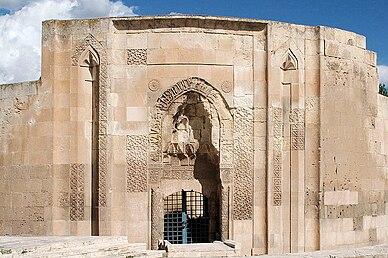Mama Hatun
Melike Mama Hatun, or simply Mama Hatun or Mamakhatun, was a female ruler of the Saltukids, with its capital in Erzurum, for an estimated nine years between 1191 and 1200.
During her reign she had a caravanserai, a mosque, a bridge, and a hammam built in the town of Tercan, located midway between Erzincan and Erzurum, which are still standing and are named after her.[2]
Her tomb, built by masters from Ahlat, is also in Tercan,[3] although the attribution to Mama Hatun is only the result of a strong oral tradition.[1] One of the secondary tombs is dated 1203, which tends to corroborate the general date of the building.[1] An inscription mentions the builder of the structure:[1]
The work of Abu’l Muna bin Mufaddal al-Awhal ... al-Khilati, the builder, may God pardon him, as well as his father and his mother.[1]
The town itself was called Mamahatun until recently, and is still referred to as such locally. During her reign she built mosques, a medrese, several mekteps, shadirvans, caravanserais, and other types of Islamic architecture. She also built many hammams throughout her rule.
Mama Hatun also remains a vivacious figure in Turkish folk literature to this day.
See also
[edit]References
[edit]- ^ a b c d e Eastmond, Antony (1 January 2017). Tamta's World: The Life and Encounters of a Medieval Noblewoman from the Middle East to Mongolia. Cambridge University Press. pp. 290–294. doi:10.1017/9781316711774.011.
The only parallels to them come from the Christian monuments of the Caucasus, such as the zhamatun of the church of the Holy Apostles in Ani, and the Akhlati-built Sitte Melik in Divrigi.
- ^ T.A. Sinclair, Eastern Turkey: An Architectural & Archaeological Survey, II, London, 1989, p. 282.
- ^ O. Pancaroğlu, The House of Mengüjek in Divriği: Constructions of Dynastic Identity in the Late Twelfth Century, in A. Peacock - S. Nur Yildiz (edd.), The Seljuks of Anatolia: Court and Society in the Medieval Middle East, London - New York, 2013, p. 57, D. Darke, Eastern Turkey, Chalfont St. Peter - Guilford, 2014², p. 137.
Sources
[edit]- Sevim, Ali: Türk Tarihi – Fetih, Selçuklu ve Beylikler Dönemi, Türk Tarih Kurumu 1989; p207/208
- Dursun Ali Şeker, art. MAMA HATUN (ö. 597/1201'den sonra) Saltuklu melikesi (1191 - 1200), in İslâm Ansiklopedisine 27 (2003), p. 548.
Text is available under the CC BY-SA 4.0 license; additional terms may apply.
Images, videos and audio are available under their respective licenses.



